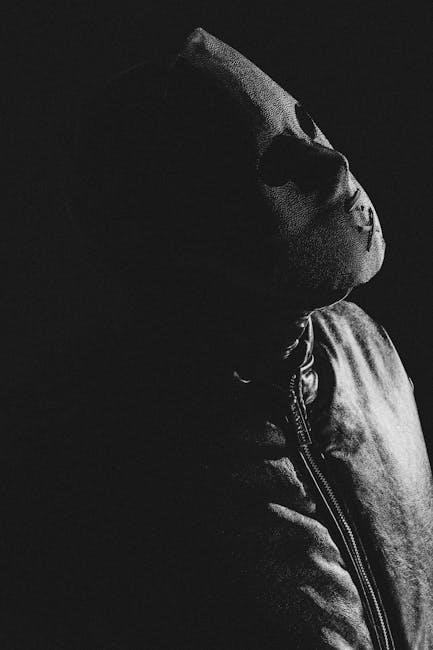Hidden Figures reveals the untold stories of African American women who played crucial roles in NASA’s success․ This inspiring film adaptation highlights their groundbreaking contributions to the space race and beyond․
1․1 Overview of the Movie
Hidden Figures is a biographical drama film that tells the story of three African American women—Katherine Johnson, Dorothy Vaughan, and Mary Jackson—who worked at NASA during the early years of the space race․ The movie highlights their pivotal roles in the success of NASA’s missions, despite facing racism and sexism in the workplace․ Set in the 1960s, the film follows their journeys as they break barriers and challenge societal norms to achieve their goals․ Katherine Johnson, a brilliant mathematician, calculates trajectories for historic flights, including John Glenn’s orbit around Earth․ Dorothy Vaughan leads a team of “human computers” and becomes a supervisor, while Mary Jackson pursues her dream of becoming an engineer․ The film, released in 2016 and directed by Theodore Melfi, celebrates their resilience, determination, and the lasting impact of their contributions to NASA and American history․
1․2 Historical Context
Hidden Figures is set during the early 1960s, a time of significant racial and gender inequality in the United States․ The film coincides with the height of the Cold War and the space race, where NASA was under immense pressure to land a man on the moon․ The story takes place in Hampton, Virginia, where segregation was still prevalent, and African Americans faced systemic discrimination․ The Civil Rights Movement was gaining momentum, challenging the status quo and inspiring individuals to fight for equality․ Against this backdrop, the film highlights the contributions of African American women who worked as “human computers” at NASA, performing critical mathematical calculations for its missions․ Despite their expertise, these women faced both racial and gender barriers, making their achievements even more remarkable․ The film sheds light on this overlooked chapter of American history, showcasing the resilience and determination of these trailblazers during a transformative era․
1․3 Importance of the Story
Hidden Figures is a powerful narrative that highlights the often-overlooked contributions of African American women in STEM fields during the early years of the space race․ The story is significant because it challenges historical erasure by bringing to light the achievements of Katherine Johnson, Dorothy Vaughan, and Mary Jackson, who defied societal norms and racial barriers to excel in their careers․ Their journeys inspire future generations to pursue STEM education and careers, particularly underrepresented groups․ The film also underscores the importance of diversity and inclusion in driving innovation and progress․ By sharing their stories, Hidden Figures fosters a deeper understanding of the obstacles faced by women of color and celebrates their resilience and determination․ It serves as a reminder of the transformative impact of equality and representation in shaping both individual and collective success․

Key Characters in Hidden Figures
Katherine Johnson, Dorothy Vaughan, and Mary Jackson are the central figures, each showcasing exceptional talent and resilience․ Their stories highlight their contributions to NASA’s success while overcoming racial and gender barriers․
2․1 Katherine Johnson
Katherine Johnson was a brilliant African American mathematician who played a pivotal role at NASA․ Her exceptional skills in analytical geometry made her indispensable during the early years of the space program․ Katherine’s calculations were crucial for the success of astronaut Alan Shepard’s suborbital flight and John Glenn’s historic orbital mission․ Despite facing racism and sexism, she broke barriers, earning the respect of her colleagues․ Her story, highlighted in Hidden Figures, showcases her determination, intellect, and contributions to breaking down racial and gender barriers in STEM fields․ Katherine’s legacy continues to inspire future generations, proving that talent and perseverance can overcome any obstacle․ Her work at NASA remains a testament to her groundbreaking achievements in a male-dominated environment․ Katherine Johnson’s impact on space exploration and equality is immeasurable, cementing her place in history as a true trailblazer․

2․2 Dorothy Vaughan
Dorothy Vaughan was a trailblazing mathematician and supervisor at NASA who led the African American women in the segregated West Area Computing Unit․ She played a pivotal role in advocating for her team’s recognition and equal opportunities․ Dorothy’s exceptional leadership and mathematical skills earned her the respect of her peers and superiors alike․ She was instrumental in breaking down racial barriers, pushing for promotions, and challenging the status quo․ Her determination to learn and adapt led her to transition into computer programming, ensuring her relevance as NASA embraced technological advancements․ Dorothy’s legacy extends beyond her technical contributions; she empowered her team to strive for excellence and fight for their rightful place in a segregated workplace․ Her story, as depicted in Hidden Figures, highlights her resilience, intelligence, and unwavering commitment to equality․ Dorothy Vaughan’s impact on NASA and the fight for civil rights remains a powerful inspiration for future generations․
2․3 Mary Jackson
Mary Jackson was a trailblazing engineer and mathematician at NASA, breaking barriers as one of the first African American women to achieve the title of engineer․ Born in Virginia, Mary’s passion for mathematics and science led her to join NASA’s segregated West Area Computing Unit․ Her exceptional talent and perseverance earned her a promotion to engineer, a role previously reserved for white men․ Mary’s story in Hidden Figures highlights her determination to overcome racial and gender obstacles, including her fight to attend segregated classes required for her promotion․ Her contributions to NASA’s aeronautical research were pivotal, and her legacy inspires future generations to pursue STEM careers․ Mary’s resilience and advocacy for equality not only advanced her own career but also paved the way for others facing similar challenges․ Her journey symbolizes the power of education and the importance of challenging systemic barriers․ Mary Jackson’s impact on NASA and civil rights remains indelible․

Themes in Hidden Figures
Racism, sexism, and resilience are central themes, showcasing the women’s struggle against segregation and gender bias․ Their talent and determination highlight the power of education and equality in overcoming societal barriers․
3․1 Racism and Segregation
Racism and segregation are prominent themes in Hidden Figures, as the film portrays the systemic discrimination faced by African American women at NASA during the 1960s․ The characters endure separate facilities, limited career advancement, and societal prejudice, highlighting the racial barriers of the time․ Despite their exceptional skills, they are often marginalized and underestimated due to the color of their skin․ The movie vividly depicts how segregation affects their daily lives, from separate bathrooms to restricted access to resources․ However, the women’s resilience and determination to overcome these obstacles serve as a testament to their strength and the broader struggle for equality․ The film sheds light on the invisible barriers faced by African American women in STEM fields, emphasizing the importance of breaking down racial and gender stereotypes․ Their achievements not only advanced NASA’s mission but also inspired future generations to challenge systemic inequality․
3․2 Sexism in the Workplace
Sexism in the workplace is a significant challenge faced by the characters in Hidden Figures․ The film highlights the gender-based discrimination and stereotypes that women, particularly African American women, encountered in male-dominated fields like engineering and mathematics․ Katherine Johnson, Dorothy Vaughan, and Mary Jackson often find themselves overlooked for promotions, excluded from key meetings, and undervalued despite their exceptional abilities․ The societal norms of the 1960s further exacerbate these issues, as women are expected to conform to traditional roles rather than pursue careers in STEM․ The movie portrays their resilience and determination to break down these barriers, showcasing how they prove their worth in a system designed to hold them back․ Their struggles and successes serve as a powerful reminder of the importance of challenging gender stereotypes and fostering equality in the workplace․ Their legacy continues to inspire women to pursue careers in STEM and fight against systemic bias․
3․3 The Power of Education
Education is a central theme in Hidden Figures, as it serves as a tool for empowerment and overcoming societal barriers․ The film underscores how access to knowledge and skill development enables individuals to challenge systemic inequalities․ Katherine Johnson’s extraordinary mathematical abilities, Dorothy Vaughan’s leadership in learning FORTRAN, and Mary Jackson’s determination to become an engineer exemplify the transformative power of education․ The movie highlights how these women leveraged education to break down racial and gender barriers, proving that intellectual prowess knows no bounds․ Their stories inspire viewers to value education as a means to achieve personal and professional growth․ By portraying the characters’ relentless pursuit of learning, the film emphasizes the importance of education in fostering equality and opportunities․ This theme resonates deeply, encouraging audiences to recognize the potential of education to transcend limitations and create a more inclusive future․

Educational Guide Components
Educational guides for Hidden Figures include lesson plans, discussion questions, and activities․ These tools help students engage with the film’s themes, characters, and historical context, fostering critical thinking and deeper understanding․
4;1 Lesson Plans
Lesson plans for Hidden Figures are designed to integrate the film’s themes into curriculum․ They include objectives like analyzing the characters’ roles in NASA’s history and understanding the impact of racism and sexism․ Activities such as group discussions and problem-solving tasks encourage critical thinking․ Teachers can use scene-based exercises to highlight mathematical and engineering concepts, showcasing the women’s contributions․ The plans also emphasize the importance of perseverance and education, aligning with STEM initiatives․ Additional resources, like biographies of Katherine Johnson, Dorothy Vaughan, and Mary Jackson, provide historical context․ These lesson plans are adaptable for various grade levels, ensuring students grasp the film’s inspirational message and its relevance to modern society․ By connecting cinematic storytelling with academic goals, educators can inspire students to pursue careers in STEM fields while appreciating the legacy of these trailblazers․
4․2 Discussion Questions
Discussion questions for Hidden Figures encourage students to reflect on the film’s themes and characters․ Questions like, “How did Katherine Johnson’s mathematical skills impact NASA’s success?” prompt analysis of her contributions․ Others, such as “What challenges did Dorothy Vaughan face in leading her team?” explore leadership and perseverance․ Questions about Mary Jackson’s journey to becoming an engineer highlight the importance of education and determination․ Discussions also focus on broader themes: “How did racism and sexism affect the women’s careers?” and “What role did mentorship play in their success?” Students are encouraged to connect the film’s messages to real-life issues, such as “How do the themes of Hidden Figures relate to modern-day challenges in STEM?” These questions foster critical thinking and empathy, helping students appreciate the women’s legacy and the film’s inspirational impact․
4․3 Activities for Students
Activities for students are designed to deepen understanding of Hidden Figures while fostering critical thinking and creativity․ One activity involves solving math problems inspired by Katherine Johnson’s calculations, such as determining orbital trajectories․ Students can also research and present on the historical contributions of African American women in STEM fields․ Group discussions and debates on themes like racism and sexism encourage empathy and reflection․ A creative writing or art project allows students to express the emotional impact of the film․ Additionally, students can design a timeline of NASA’s key milestones, highlighting the roles of Johnson, Vaughan, and Jackson․ These activities promote engagement with the film’s messages and inspire students to pursue STEM careers․ By connecting the movie’s lessons to real-world issues, students gain a deeper appreciation for the power of perseverance and education․ These exercises are tailored to enhance learning and encourage students to think critically about history and its relevance today․

Answer Key Sections
Answer Key Sections provide detailed responses to character analysis, theme-based questions, and historical context queries․ This section serves as a reference for educators to assess student understanding and guide further discussion effectively․
5․1 Character Analysis Answers
Katherine Johnson was a brilliant mathematician whose calculations were pivotal in NASA’s missions․ Her accuracy and determination broke racial barriers, showcasing her as a trailblazer in STEM․
Dorothy Vaughan led the African American women in the segregated “West Area” of NASA․ She fought for promotions and recognition, inspiring her team to excel despite systemic discrimination․
Mary Jackson became NASA’s first African American female engineer․ Her resilience in pursuing her education and career path highlighted the challenges faced by women in male-dominated fields․
These characters exemplify perseverance, intelligence, and the fight for equality, making their stories central to the film’s message of overcoming adversity and achieving greatness․ Their contributions remain timeless inspirations․
5․2 Theme-Based Questions

How does the film portray the intersection of racism and sexism in the workplace, and what impact does this have on the characters?
In what ways does Katherine Johnson’s mathematical genius challenge stereotypes about African Americans and women in STEM fields?
How does Dorothy Vaughan’s leadership inspire her team, and what does this reveal about the importance of mentorship?
What role does education play in the lives of the main characters, and how does it empower them to overcome obstacles?
How does the film highlight the tension between segregation and integration at NASA, and what message does this convey?
What does Mary Jackson’s journey to becoming an engineer teach us about perseverance and breaking barriers?
How does the film use the space race as a backdrop to explore broader societal issues?
In what ways do the characters’ personal lives reflect their professional struggles and triumphs?
These questions encourage critical thinking about the film’s themes and their relevance to real-world issues․
5․3 Historical Context Answers
The film Hidden Figures is set during the early years of NASA and the U․S․ space program, highlighting the contributions of African American women mathematicians and engineers․ The story takes place in the 1960s, a time when segregation and racial discrimination were prevalent in the United States․ The characters’ experiences reflect the broader historical context of the Civil Rights Movement and the fight for equality․ The film accurately portrays the segregated working conditions at NASA, where African American employees, including Katherine Johnson, Dorothy Vaughan, and Mary Jackson, were separated from their white counterparts․ The term “colored computers” was used to describe the African American women who performed mathematical calculations for NASA’s engineers․ The film also captures the pivotal moment when NASA’s facilities were desegregated, marking a step toward equality․ These historical details emphasize the barriers faced by the characters and their resilience in overcoming them to achieve greatness․

The Impact of Hidden Figures
Hidden Figures sparked a cultural shift, inspiring diverse representation in STEM fields․ It highlighted the untold stories of African American women, breaking stereotypes and motivating future generations to pursue careers in science and technology․
6․1 Cultural Impact
The release of Hidden Figures sparked a profound cultural shift, shedding light on the overlooked contributions of African American women in STEM․ By sharing their stories, the film challenged stereotypes and inspired a new wave of diversity in representation․ It created an emotional connection with audiences, celebrating the resilience and brilliance of Katherine Johnson, Dorothy Vaughan, and Mary Jackson․ The movie not only honored their legacy but also ignited conversations about race, gender, and opportunity․ Its impact extended beyond the screen, influencing media portrayal and educational curriculums․ The film became a symbol of empowerment, proving that untold stories deserve recognition․ By highlighting their achievements, Hidden Figures left a lasting legacy, encouraging future generations to embrace their potential and pursue careers in science and technology․ Its cultural significance continues to resonate, making it a pivotal moment in modern history․

6․2 Educational Influence
Hidden Figures has had a transformative impact on education, particularly in STEM fields․ The film’s portrayal of Katherine Johnson, Dorothy Vaughan, and Mary Jackson has inspired educators to incorporate their stories into curriculums․ Many schools now use the movie as a teaching tool, with guided notes and discussion questions available to explore themes like perseverance, equality, and innovation․ This has sparked student interest in math and science, especially among underrepresented groups․ The film also highlights the importance of mentorship and lifelong learning, encouraging students to pursue higher education․ Its influence extends to universities, where it has become a case study for diversity in STEM․ By showcasing real-life heroes, Hidden Figures has bridged the gap between history and modern education, motivating students to embrace their potential and strive for excellence․ Its educational impact continues to grow, fostering a more inclusive and inspired learning environment․
6․3 Inspiration for STEM Careers
Hidden Figures has become a powerful catalyst for inspiring individuals, particularly women and minorities, to pursue STEM careers․ The film’s depiction of Katherine Johnson, Dorothy Vaughan, and Mary Jackson’s achievements has shattered stereotypes and shown that talent and determination can overcome barriers․ Many young students, especially girls, have been motivated to explore math and science after watching the movie․ The film’s success has also led to initiatives and programs aimed at promoting diversity in STEM fields․ Educators and organizations use the movie as a tool to encourage students to see themselves in STEM roles․ By highlighting the contributions of these trailblazers, Hidden Figures has created a ripple effect, inspiring a new generation to pursue careers in engineering, mathematics, and technology․ Its impact is evident in the increased interest in STEM education and the growing number of diverse applicants to STEM programs worldwide․

Behind the Scenes
Hidden Figures was adapted from Margot Lee Shetterly’s book, filmed in Georgia and Virginia, and directed by Theodore Melfi․ The casting of Taraji P․ Henson, Octavia Spencer, and Janelle Monáe brought the story to life․
7․1 The Book Adaptation
Hidden Figures is based on Margot Lee Shetterly’s non-fiction book, which chronicles the lives of Katherine Johnson, Mary Jackson, and Dorothy Vaughan․ The book highlights their pivotal roles at NASA during the early years of the space race, despite facing racial and gender barriers․ Shetterly’s work sheds light on their mathematical brilliance and resilience, making their stories accessible to a broader audience․ The book became a bestseller, sparking widespread interest in these unsung heroes․ Its success led to the film adaptation, which further amplified their legacy; The adaptation process involved condensing complex narratives while maintaining historical accuracy․ The book and film together have inspired educational initiatives and discussions about diversity in STEM fields․ Their stories continue to resonate, proving the power of perseverance and talent in overcoming adversity․ The adaptation ensured their contributions are forever remembered in American history;
7․2 Filming Locations
The filming of Hidden Figures took place in various locations across the United States, with a focus on capturing the authenticity of the 1960s setting․ Key scenes were shot in Atlanta, Georgia, where historic buildings were used to replicate NASA’s Langley Research Center․ The production team also filmed in Cape Canaveral, Florida, to depict the iconic rocket launches․ Additional scenes were shot in Richmond, Virginia, and other nearby areas to represent the characters’ homes and community environments․ The filmmakers carefully selected locations that mirrored the real-life settings of Katherine Johnson, Dorothy Vaughan, and Mary Jackson’s lives․ These choices enhanced the film’s historical accuracy and provided a visually immersive experience for viewers․ The blend of real and recreated locations helped bring the story to life, ensuring that the audience could connect with the time and place of the characters’ remarkable journeys․
7․3 Casting Choices
The casting of Hidden Figures was a deliberate and thoughtful process, ensuring that the actors could authentically portray the real-life heroes․ Taraji P․ Henson was chosen for the lead role of Katherine Johnson, bringing depth and nuance to the character․ Octavia Spencer was cast as Dorothy Vaughan, embodying the strength and leadership of the role․ Janelle Monáe played Mary Jackson, capturing her determination and ambition․ The casting of Kevin Costner as Al Harrison, Katherine’s supervisor, added gravity to the film, while Kirsten Dunst portrayed Vivian Mitchell, highlighting the complexities of workplace dynamics․ The actors’ performances were widely praised, with many earning award nominations․ The diverse cast reflected the true story’s essence, showcasing the contributions of African American women in STEM․ The casting choices were instrumental in bringing the inspiring story to life, ensuring that the characters’ journeys resonated with audiences worldwide․

Leave a Reply
You must be logged in to post a comment.